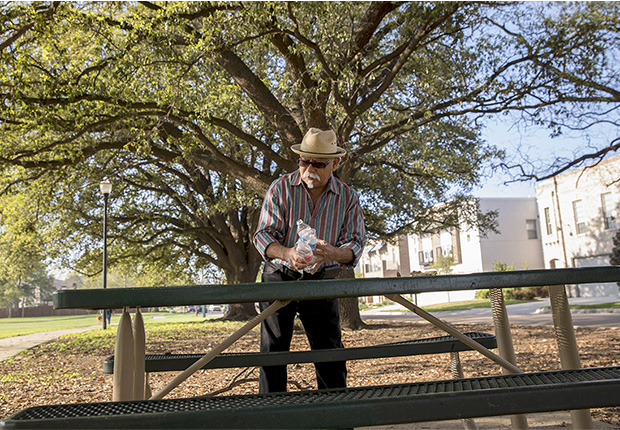AARP Hearing Center

By Tom Korosec
On a chilly day late last October, Bob Bonilla and other AARP volunteers grabbed brooms and paintbrushes and went to work making their Fort Worth neighborhood more walkable and age-friendly.
They painted curbs and crosswalks and created a “pop-up” traffic circle to slow vehicles and make their gentrifying neighborhood safer for pedestrians.
“Earlier we did a walking tour to identify some of the problems,” said Bonilla, 67, a retired schoolteacher. They noted that residents of a nearby senior housing complex, on their way to the grocery store, were forced to drive their mobility chairs in the street on several blocks because of inadequate sidewalks or crosswalks blocked by parked cars.
The effort in the Linwood neighborhood near downtown was sponsored by AARP’s Livable Communities initiative and Team Better Block, a Dallas urban planning group.
Fort Worth and five other Texas cities—Austin, Brownsville, Dallas, Houston and San Antonio—have joined the AARP Network of Age-Friendly Communities. The network includes more than 230 localities that committed to making their communities great places for people of all ages.
Goals include safe, walkable streets; age-friendly housing; a variety of public transit options; and access to services.
Melodía Gutiérrez, AARP Texas outreach and advocacy director, said the program helps “let people age in place, gives them adequate social interaction and a safe place to play and work.”
With a few days of effort in Fort Worth, she added, “we demonstrated how really small changes can make a huge impact.”
A boost for pedestrians
The temporary circle at one intersection, using rubber barriers, slowed down traffic. Drivers stopped parking too close to corners and blocking crosswalks after volunteers painted the curbs red.
The initiative also included solar-powered streetlights, deck chairs and a ping-pong table in Linwood’s neighborhood park.
Organizers capped off the work with a block party, giving them a chance to talk with many residents. Bonilla served as DJ.
City officials were impressed with the traffic circle and promised to make it permanent, organizers said. The city also installed several stop signs to further slow traffic and repainted crosswalks with more durable paint. The project pushed the neighborhood’s concerns higher on the city’s priority list, Gutiérrez said.
Linwood, hit by a tornado in 2000, has been made over in the past two decades with higher-density apartments and town houses. That’s brought additional cars, and others taking shortcuts through the neighborhood’s narrow streets, endangering pedestrians and cyclists—and raising residents’ concerns.
“I love what they’re doing,” Fort Worth Mayor Betsy Price said of the Linwood effort. “It started small and grassroots, and it’s a tremendous way for neighbors to coalesce around getting their neighborhood more livable, more walkable.”
When people work on their own neighborhoods, “you get much better buy-in,” Price added. “If we went in and said, ‘We’re going to put a roundabout in the middle of your neighborhood,’ half the folks would hate it. In this case there might be a few naysayers, but not many.”
Bonilla said this is just the start: “We’ve got some positive forces going on here. With that we can accomplish anything.”
For more on the AARP Network of Age-Friendly Communities, go to aarp.org/livable.
Thomas Korosec is a writer living in Dallas.































































